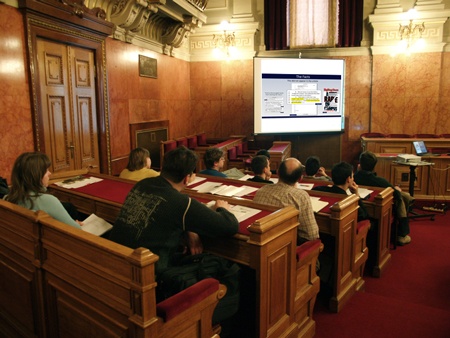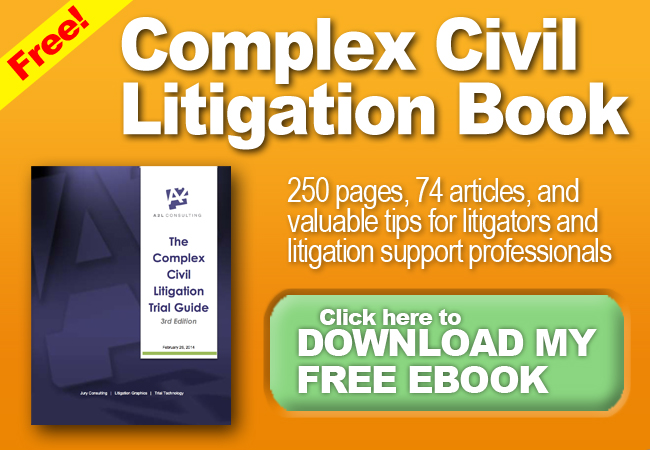 by Ken Lopez
by Ken Lopez
Founder/CEO
A2L Consulting
I’ve seen a great many lawyers read documents aloud at trials, and, not coincidentally, I’ve seen lawyers lose cases in part because they did so. Both experience and the science of persuasion tell us that reading documents to a jury is a persuasion killer. But of course there are times when you absolutely need to read a document out loud. This article will help you find the best ways to do so when it is necessary.
There are at least five good reasons why reading documents out loud is harmful. I will go through them, then offer three guidelines for reading passages of text to a jury or judge when it is necessary. After all, it’s hard to imagine trying a contract case without reading the key provisions of the contract.
- The split-attention effect/redundancy effect is easy to recognize, and we've all experienced it. In summary, if you are presented with a written document and it is read to you at the same time, your brain will have a hard time sorting out whether to read or to listen. What you might not know is that you actually end up far worse off reading written materials while seeing an image of those materials than you would have if you had just done one or the other -- read the materials or listened to the words. See The Redundancy Effect, PowerPoint and Legal Graphics.
- Related closely to the split attention the fact is the fact that people read faster than you speak. So if you present both formats, whether you know it or not, you have just started a little competition with your audience. They try to read faster than you. See
Why Reading Your Litigation PowerPoint Slides Hurts Jurors.
- People have written books about why this is a bad practice. Just read Cliff Atkinson’s Beyond Bullet Points, www.beyondbulletpoints.com.
- There's more science about this than you probably think. Chris Atherton's work is superb on this topic, and here's a video about it. https://www.youtube.com/watch?v=OwOuVc1Qrlg
- If you read out loud to people, you'll probably bore them. See Could Surprise Be One of Your Best Visual Persuasion Tools?
So, now that you have an idea about why reading documents is bad, how do we deal with the fact that some documents just need to be read? To deal with that, you will likely have to embrace new habits and learn new skills.
First, assuming that you are presenting from Trial Director or PowerPoint, you're going to need to learn when and how to turn off the projector. In PowerPoint you do this by pressing the bulb symbol, which toggles the screen to and from a black screen. In Trial Director, assuming that you are making appropriate use of a trial technician’s experience and professionalism by having a technician run the equipment in the courtroom, just say, “Dim the screen please.” When you do this, the jury should stare at you and pay close attention.
Second, you should choose passages of text to read that are as short as possible. I recommend never reading more than a sentence or two.
Third, try to become comfortable with pausing and giving people a chance to read. Look at the document yourself and read along quietly in your head. You'll get a feeling for how long people need, and you will keep the factfinders engaged. If you now want to highlight some key language, highlight it and ask the jury to focus on that piece again, then pause again. Then dim the screen, briefly reread it and then explain why it's important. Scientifically, this is your single best approach to maximize persuasion. I acknowledge it feels different and tedious, but so once did washing your hands before surgery.
Other articles from A2L Consulting discussing presenting orally and with documents, the redundancy effect, and using science to persuade:
- 6 Trial Presentation Errors Lawyers Can Easily Avoid
- 12 Ways to SUCCESSFULLY Combine Oral and Visual Presentations
- Free E-Book Download: Using Litigation Graphics to Persuade and Win
- Free E-Book Download: Designing a GREAT Visual Presentation
- Free Webinar - Watch Now: Storytelling in Litigation
- 6 Studies That Support Litigation Graphics in Courtroom Presentations
- Why Reading Bullet Points in Litigation Graphics Hurts You
- 3 Styles of Document Call-outs Used at Trial
- The 12 Worst PowerPoint Mistakes Litigators Make
- 16 PowerPoint Litigation Graphics You Won't Believe Are PowerPoint
- 16 Litigation Graphics Lessons for Mid-Sized Law Firms
- 6 Trial Presentation Errors Lawyers Can Easily Avoid
- 21 Steps I Took For Great Public Speaking Results






Leave a Comment